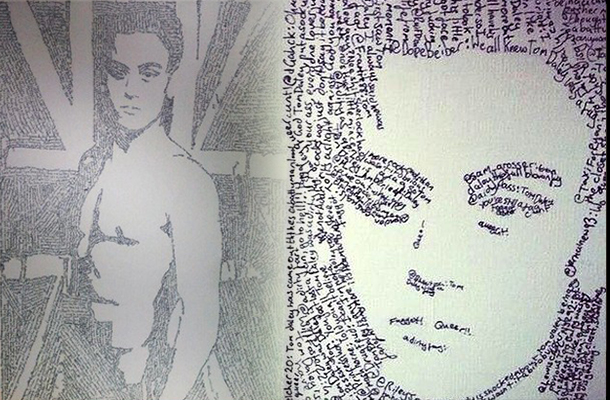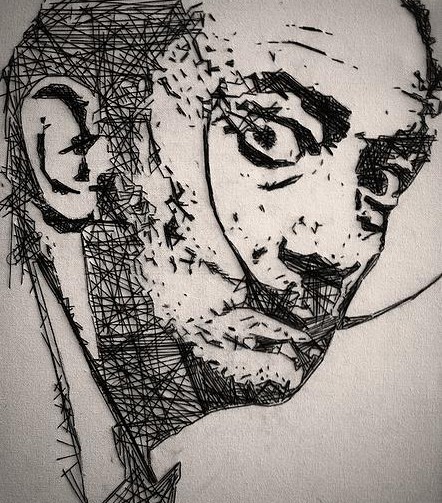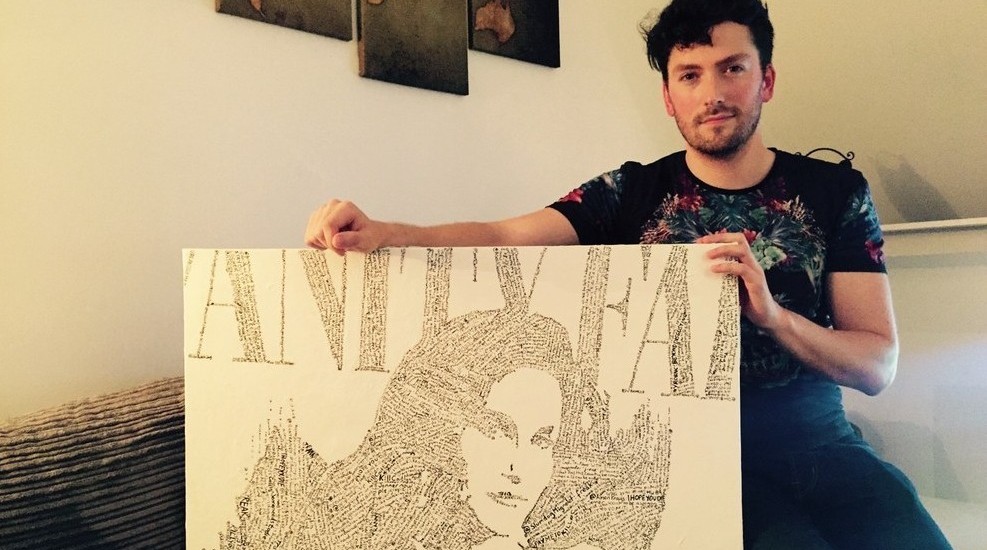Conor Collins: Turning hate into art
When Internet trolls find a target, it’s rare that anything positive comes as a result. However British artist Conor Collins proves this is not always the case. After Olympian diver Tom Daley revealed he was in a relationship with a man in 2013, along with messages of love and support from people worldwide, the young sportsman received his fair share of hate. Angry at the outpouring of homophobia, Collins created a striking portrait of Daley composed of hundreds of abusive tweets, a painting that was widely shared through social media.
“I created it as a vent for my anger at how he was being treated,” Collins says. “It seemed so wrong that someone who was announcing that they have fallen in love with someone would receive such horrendous abuse. I grabbed a canvas, opened Twitter, and just started working. Later that night, I tweeted it and didn’t think much more. When I woke up to 1000 notifications the next day, I understood it had struck a chord with people.”

Collins produced a similar piece earlier this year, recreating Caitlyn Jenner’s now iconic Vanity Fair cover using transphobic tweets. The piece quickly went viral, and was viewed on Twitter by more people in one week than had visited the Museum of Modern Art in the previous three years.
Having had a taste of international fame, I wonder whether Collins feels pressured to make work that will be picked up by news outlets. “If I started to create art with that in mind, I will have just made a marketable picture, not good art,” Collins says. “I don’t make art for people to like it, that’s just a bonus. If tomorrow my art was completely forgotten, it wouldn't stop me making piece after piece. It’s an absolute need I have now, to create art.”
Collins may never have picked up a paintbrush at all had it not been for a love affair with an art-lover. “To me, he was the only person in the world and everything I did drew me closer to him with each day,” Collins ruminates. “I was in complete denial however, and even when I was creating paintings of him I still denied how much I loved him. When I realised I had fallen in love, I completely broke down. Everything stopped. However once the dust had settled, the art came back like the tide. He may have started me painting, but nothing would stop it.”

 (These portraits are best viewed from a distance.)
(These portraits are best viewed from a distance.)
Since then, Collins’ appetite for creating art has been insatiable. Along with a number of self-portraits, Collins is best known for his portrayals of public figures, most of who belong to the LGBT community. Oscar Wilde, Alan Turing and Stephen Fry are just some of the notable names Collins has depicted in his work in his now-signature style. Typically, clusters of words, lines or tiny dots are immaculately arranged on a canvas to form the famous faces, though Collins insists that he never intended for this technique to become his trademark. “I just get an idea and go with it,” he says. “I try not to overcomplicate, overthink or over-edit an idea.”
Though Collins is reticent about his plans for the future (“Why would I want to spoil the surprise?”), he does reveal that he would like to make something larger than any of his previous work. “I have ideas that could radically change the way we perceive art, exhibitions and galleries, however they would be bigger than anything we have seen before and also unfathomably expensive to create. So there are things I would like to make, but I will need to save my pennies before I can create them.”
While Collins may have to wait a while before he can make art on such a large scale, interest in his work shows so sign of stopping. With his finger firmly on the pulse of popular culture, enough talent to fill a gallery and his fair share of celebrity fans, surely it’s only a matter of time before Collins’ big ideas become a reality.
 To see more of Conor Collins' art, visit his website here or follow him on Twitter here.
To see more of Conor Collins' art, visit his website here or follow him on Twitter here.

